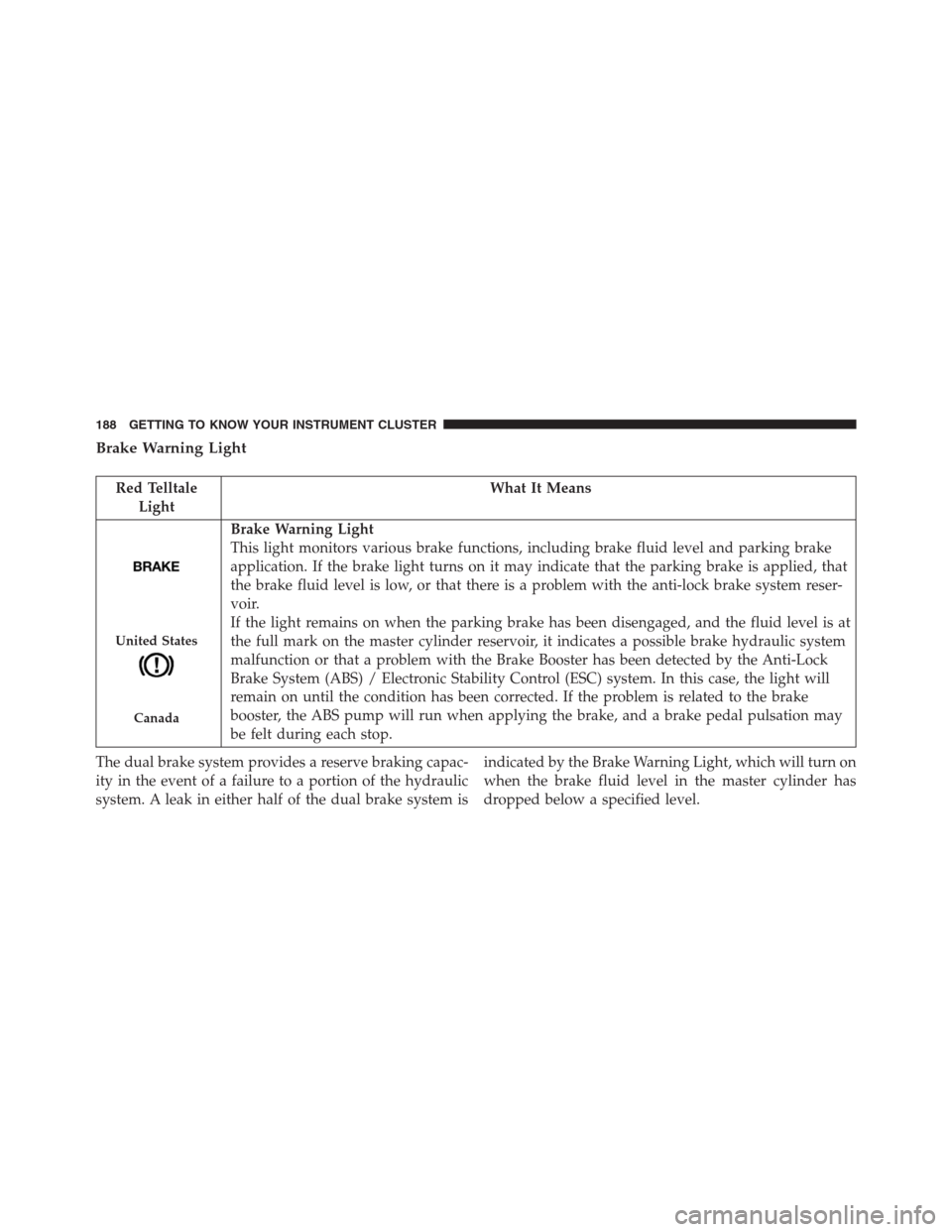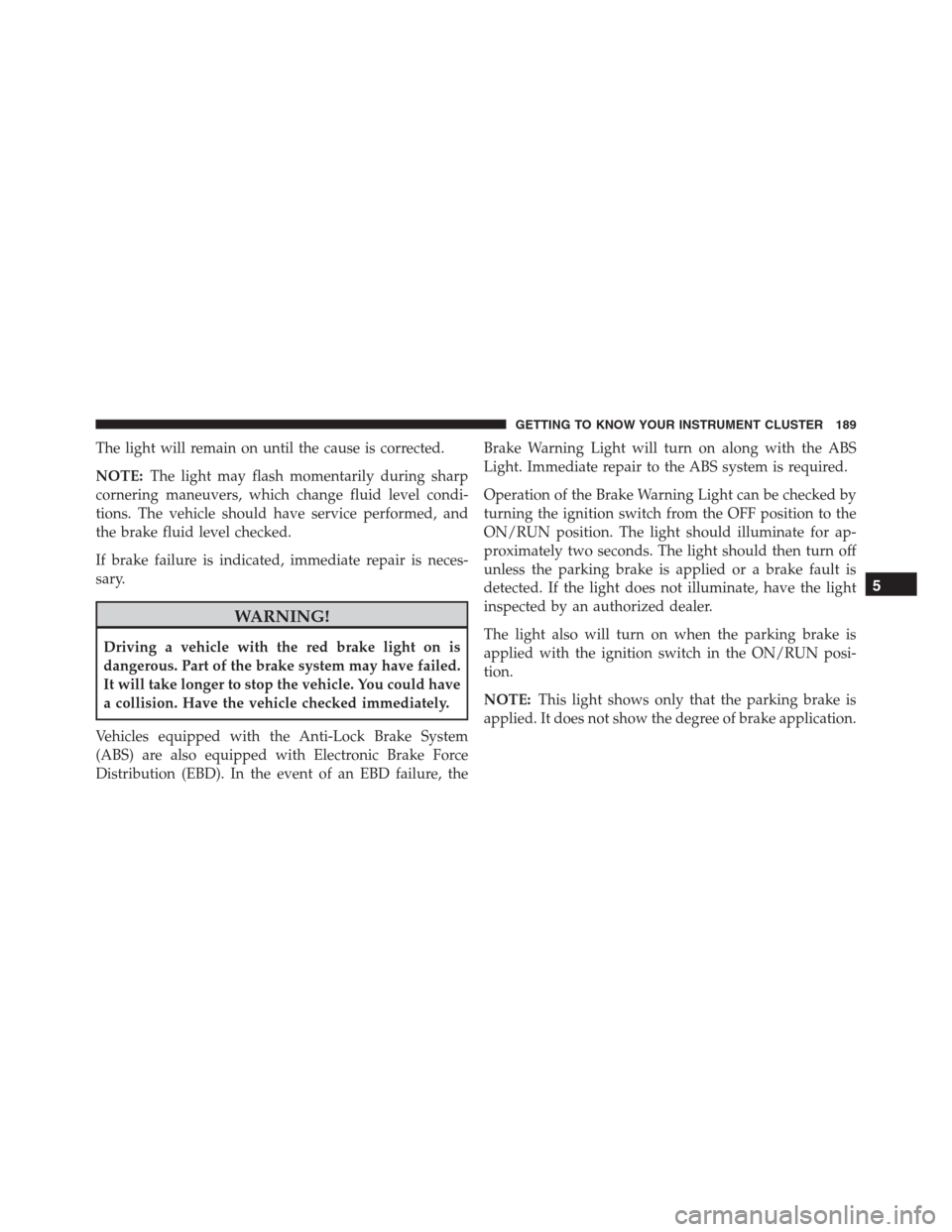Page 190 of 688

Brake Warning Light
Red Telltale
LightWhat It Means
United States
Canada
Brake Warning Light
This light monitors various brake functions, including brake fluid level and parking brake
application. If the brake light turns on it may indicate that the parking brake is applied, that
the brake fluid level is low, or that there is a problem with the anti-lock brake system reser-
voir.
If the light remains on when the parking brake has been disengaged, and the fluid level is at
the full mark on the master cylinder reservoir, it indicates a possible brake hydraulic system
malfunction or that a problem with the Brake Booster has been detected by the Anti-Lock
Brake System (ABS) / Electronic Stability Control (ESC) system. In this case, the light will
remain on until the condition has been corrected. If the problem is related to the brake
booster, the ABS pump will run when applying the brake, and a brake pedal pulsation may
be felt during each stop.
The dual brake system provides a reserve braking capac-
ity in the event of a failure to a portion of the hydraulic
system. A leak in either half of the dual brake system isindicated by the Brake Warning Light, which will turn on
when the brake fluid level in the master cylinder has
dropped below a specified level.
188 GETTING TO KNOW YOUR INSTRUMENT CLUSTER
Page 191 of 688

The light will remain on until the cause is corrected.
NOTE:The light may flash momentarily during sharp
cornering maneuvers, which change fluid level condi-
tions. The vehicle should have service performed, and
the brake fluid level checked.
If brake failure is indicated, immediate repair is neces-
sary.
WARNING!
Driving a vehicle with the red brake light on is
dangerous. Part of the brake system may have failed.
It will take longer to stop the vehicle. You could have
a collision. Have the vehicle checked immediately.
Vehicles equipped with the Anti-Lock Brake System
(ABS) are also equipped with Electronic Brake Force
Distribution (EBD). In the event of an EBD failure, theBrake Warning Light will turn on along with the ABS
Light. Immediate repair to the ABS system is required.
Operation of the Brake Warning Light can be checked by
turning the ignition switch from the OFF position to the
ON/RUN position. The light should illuminate for ap-
proximately two seconds. The light should then turn off
unless the parking brake is applied or a brake fault is
detected. If the light does not illuminate, have the light
inspected by an authorized dealer.
The light also will turn on when the parking brake is
applied with the ignition switch in the ON/RUN posi-
tion.
NOTE:This light shows only that the parking brake is
applied. It does not show the degree of brake application.
5
GETTING TO KNOW YOUR INSTRUMENT CLUSTER 189
Page 241 of 688

BRAKE SYSTEM
Your vehicle is equipped with dual hydraulic
brake systems. If either of the two hydraulic
systems loses normal capability, the remaining
system will still function. However, there will
be some loss of overall braking effectiveness. This will be
evident by increased pedal travel during application and
greater pedal force required to slow or stop the vehicle. In
addition, if the malfunction is caused by a leak in the
hydraulic system, the “Brake Warning Light” will turn on
as the brake fluid level drops in the master cylinder.
In the event power assist is lost for any reason (i.e.,
repeated brake applications with the engine OFF) the
brakes will still function. However, the effort required to
brake the vehicle will be much greater than that required
with the power system operating.
WARNING!
•Riding the brakes can lead to brake failure and
possibly a collision. Driving with your foot resting
or riding on the brake pedal can result in abnor-
mally high brake temperatures, excessive lining
wear, and possible brake damage. You would not
have your full braking capacity in an emergency.
•Driving a vehicle with the “Brake Warning Light”
on is dangerous. A significant decrease in braking
performance or vehicle stability during braking
may occur. It will take you longer to stop the
vehicle or will make your vehicle harder to control.
You could have a collision. Have the vehicle
checked immediately.
6
SAFETY 239
Page 318 of 688
Periodic Safety Checks You Should Make Outside
The Vehicle
Tires
Examine tires for excessive tread wear and uneven wear
patterns. Check for stones, nails, glass, or other objects
lodged in the tread or sidewall. Inspect the tread for cuts
and cracks. Inspect sidewalls for cuts, cracks, and bulges.
Check the wheel nuts for tightness. Check the tires
(including spare) for proper cold inflation pressure.
Lights
Have someone observe the operation of brake lights and
exterior lights while you work the controls. Check turn
signal and high beam indicator lights on the instrument
panel.
Door Latches
Check for proper closing, latching, and locking.
Fluid Leaks
Check area under vehicle after overnight parking for fuel,
engine coolant, oil, or other fluid leaks. Also, if gasoline
fumes are detected, or if fuel or brake fluid leaks are
suspected, the cause should be located and corrected
immediately.
316 SAFETY
Page 522 of 688

▫Adding Washer Fluid..................545
▫Exhaust System......................545
▫Cooling System......................547
▫Brake System........................553
▫Manual Transmission — If Equipped.......555
▫Automatic Transmission — If Equipped.....556
▫Appearance Care And Protection From
Corrosion...........................558
�LIFTING A VEHICLE...................565
�TIRE SAFETY INFORMATION.............567
▫Tire Markings........................567
▫Tire Identification Number (TIN)...........570
▫Tire Terminology And Definitions..........572▫Tire Loading And Tire Pressure...........573
�TIRES — GENERAL INFORMATION........578
▫Tire Pressure........................578
▫Tire Inflation Pressures.................580
▫Tire Pressures For High Speed Operation. . . .581
▫Radial Ply Tires......................582
▫Tire Types...........................582
▫Run Flat Tires — If Equipped.............584
▫Spare Tires — If Equipped...............585
▫Tire Spinning........................585
▫Tread Wear Indicators..................586
▫Life Of Tire.........................586
▫Replacement Tires.....................587
520 MAINTAINING AND CARING FOR YOUR VEHICLE
Page 527 of 688

Severe Duty All Models
Change Engine Oil at 4,000 miles (6,500 km) if the vehicle
is operated in a dusty and off road environment or is
operated predominately at idle or only very low engine
RPM’s. This type of vehicle use is considered Severe Duty.
NOTE:The Oil Change Indicator will not illuminate
under these conditions.
Once A Month Or Before A Long Trip:
•Check engine oil level.
•Check windshield washer fluid level.
•Check the tire inflation pressures and look for unusual
wear or damage.
•Check the fluid levels of the coolant reservoir, and
brake master cylinder reservoir, and fill as needed.
•Check function of all interior and exterior lights.Required Maintenance Intervals.
At Every Oil Change Interval As Indicated By Oil
Change Indicator System:
Change oil and filter.
Inspect battery and clean and tighten terminals as
required.
Inspect brake pads, shoes, rotors, drums, and hoses.
Inspect engine cooling system protection and hoses.
Check and adjust hand brake.
Inspect exhaust system.
Inspect engine air filter if using in dusty or off-road
conditions.
Refer to the “Maintenance Chart” on the following page
for the required maintenance intervals.
9
MAINTAINING AND CARING FOR YOUR VEHICLE 525
Page 528 of 688
Maintenance Chart
Mileage or time passed
(whichever comes first)
10,000
20,000
30,000
40,000
50,000
60,000
70,000
80,000
90,000
100,000
110,000
120,000
130,000
140,000
150,000
Years123456789101112131415
Or Kilometers
16,000
32,000
48,000
64,000
80,000
96,000
112,000
128,000
144,000
160,000
176,000
192,000
208,000
224,000
240,000
Check tire condition/wear and adjust pres-
sure, if necessary, check TIREKIT expira-
tion date (if provided).•••••••••••••••
Check operation of lighting system (head-
lamps, direction indicators, hazard warn-
ing lights, luggage compartment, passen-
ger compartment, glove compartment,
instrument panel warning lights, etc.).•••••••••••••••
Check and, if necessary, top up fluid lev-
els (brakes/hydraulic clutch, windshield
washer, battery, engine coolant, etc.).•••••••••••••••
526 MAINTAINING AND CARING FOR YOUR VEHICLE
Page 532 of 688
Mileage or time passed
(whichever comes first)
10,000
20,000
30,000
40,000
50,000
60,000
70,000
80,000
90,000
100,000
110,000
120,000
130,000
140,000
150,000
Years123456789101112131415
Or Kilometers
16,000
32,000
48,000
64,000
80,000
96,000
112,000
128,000
144,000
160,000
176,000
192,000
208,000
224,000
240,000
Replace brake fluid every two years.•••••••
Replace cabin filter.○•○•○•○•○•○•○•○
Change the manual transmission fluid if
using your vehicle for any of the following:
trailer towing, heavy loading, taxi, police,
delivery service (commercial service), off-
road, desert operation or more than 50%
of your driving is at sustained speeds dur-
ing hot weather, above 90°F (32°C).••
Flush and replace the engine coolant at
10 years or 150,000 miles (240,000 km)
whichever comes first.••
530 MAINTAINING AND CARING FOR YOUR VEHICLE